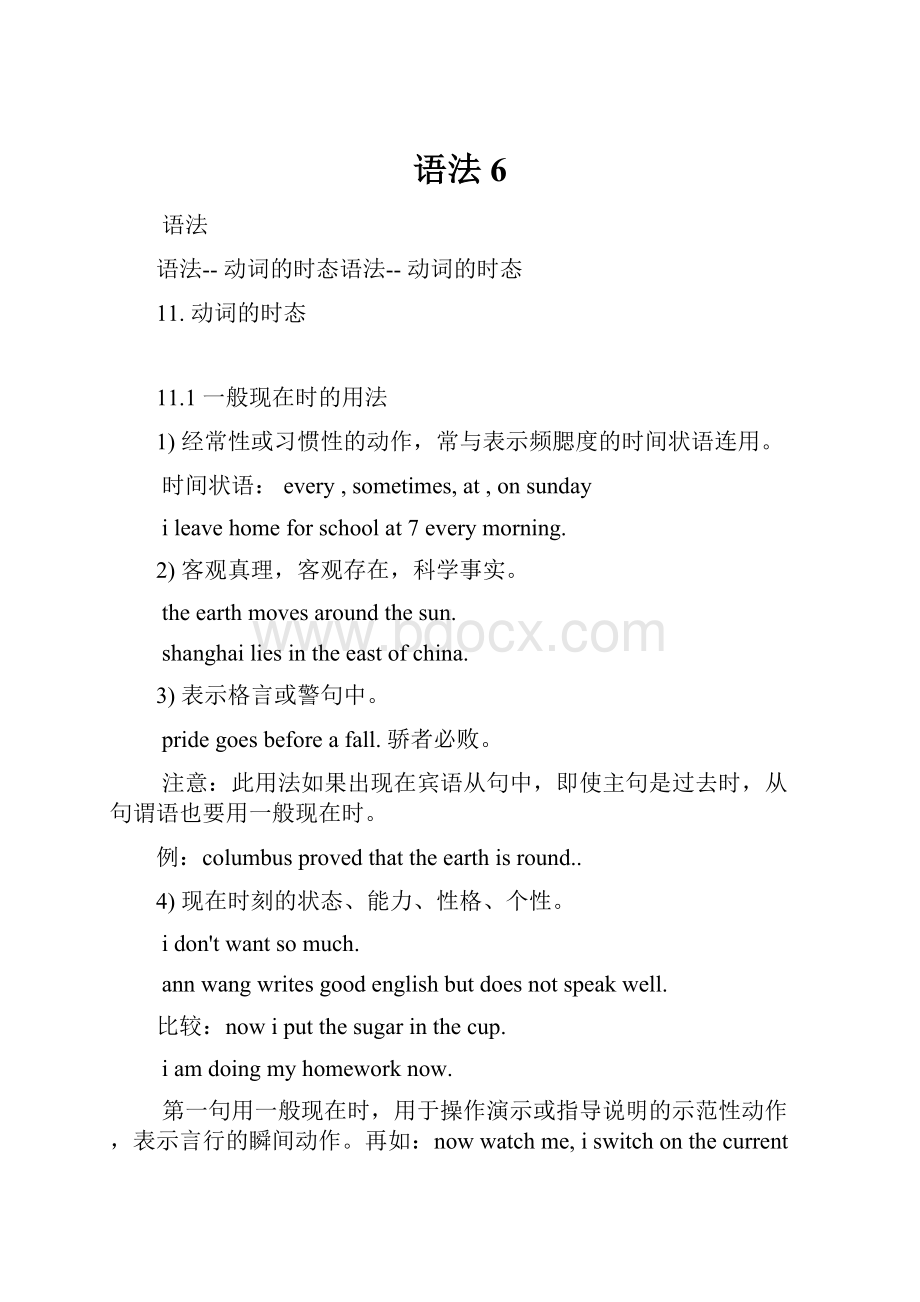语法6.docx
《语法6.docx》由会员分享,可在线阅读,更多相关《语法6.docx(20页珍藏版)》请在冰豆网上搜索。

语法6
语法
语法--动词的时态语法--动词的时态
11.动词的时态
11.1一般现在时的用法
1)经常性或习惯性的动作,常与表示频腮度的时间状语连用。
时间状语:
every,sometimes,at,onsunday
ileavehomeforschoolat7everymorning.
2)客观真理,客观存在,科学事实。
theearthmovesaroundthesun.
shanghailiesintheeastofchina.
3)表示格言或警句中。
pridegoesbeforeafall.骄者必败。
注意:
此用法如果出现在宾语从句中,即使主句是过去时,从句谓语也要用一般现在时。
例:
columbusprovedthattheearthisround..
4)现在时刻的状态、能力、性格、个性。
idon'twantsomuch.
annwangwritesgoodenglishbutdoesnotspeakwell.
比较:
nowiputthesugarinthecup.
iamdoingmyhomeworknow.
第一句用一般现在时,用于操作演示或指导说明的示范性动作,表示言行的瞬间动作。
再如:
nowwatchme,iswitchonthecurrentandstandback.第二句中的now是进行时的标志,表示正在进行的动作的客观状况,所以后句用一般现在时。
11.2一般过去时的用法
1)在确定的过去时间里所发生的动作或存在的状态。
时间状语有:
yesterday,lastweek,anhourago,theotherday,in1982等。
wheredidyougojustnow?
2)表示在过去一段时间内,经常性或习惯性的动作。
wheniwasachild,ioftenplayedfootballinthestreet.
wheneverthebrownswentduringtheirvisit,theyweregivenawarmwelcome.
3)句型:
itistimeforsb.todosth到时间了该了
itistimesb.didsth.时间已迟了早该了
itistimeforyoutogotobed.你该睡觉了。
itistimeyouwenttobed.你早该睡觉了。
would(had)rathersb.didsth.表示'宁愿某人做某事'
i'dratheryoucametomorrow.
4)wish,wonder,think,hope等用过去时,作试探性的询问、请求、建议等。
ithoughtyoumighthavesome.我以为你想要一些。
比较:
一般过去时表示的动作或状态都已成为过去,现已不复存在。
christinewasaninvalidallherlife.
(含义:
她已不在人间。
)
christinehasbeenaninvalidallherlife.
(含义:
她现在还活着)
mrs.darbylivedinkentuckyforsevenyears.
(含义:
达比太太已不再住在肯塔基州。
)
mrs.darbyhaslivedinkentuckyforsevenyears.
(含义:
现在还住在肯塔基州,有可能指刚离去)
注意:
用过去时表示现在,表示委婉语气。
1)动词want,hope,wonder,think,intend等。
didyouwantanythingelse?
iwonderedifyoucouldhelpme.
2)情态动词could,would.
couldyoulendmeyourbike?
11.3usedto/beusedto
usedto+do:
过去常常表示过去习惯性的动作或状态,但如今已不存在。
motherusednottobesoforgetful.
scarfusedtotakeawalk.(过去常常散步)
beusedto+doing:
对已感到习惯,或习惯于,to是介词,后需加名词或动名词。
heisusedtoavegetariandiet.
scarfisusedtotakingawalk.(现在习惯于散步)
典型例题
----yourphonenumberagain?
i___quitecatchit.
----it's69568442.
a.didn'tb.couldn'tc.don'td.can't
答案a.本句虽没有明确的时间状语,但从语意上看出,在听的时候没有听懂这个动作发生在过去,因此应用过去时。
11.4一般将来时
1)shall用于第一人称,常被will所代替。
will在陈述句中用于各人称,在争求意见时常用于第二人称。
whichparagraphshallireadfirst.
willyoubeathomeatseventhisevening?
2)begoingto+不定式,表示将来。
a.主语的意图,即将做某事。
whatareyougoingtodotomorrow?
b.计划,安排要发生的事。
theplayisgoingtobeproducednextmonth。
c.有迹象要发生的事
lookatthedarkclouds,thereisgoingtobeastorm.
3)be+不定式表将来,按计划或正式安排将发生的事。
wearetodiscussthereportnextsaturday.
4)beaboutto+不定式,意为马上做某事。
heisabouttoleaveforbeijing.
注意:
beaboutto不能与tomorrow,nextweek等表示明确将来时的时间状语连用。
11.5begoingto/will
用于条件句时,begoingto表将来
will表意愿
ifyouaregoingtomakeajourney,you'dbettergetreadyforitassoonaspossible.
nowifyouwilltakeoffyourclothes,wewillfitthenewclothesonyouinfrontofthemirror.
11.6beto和begoingto
beto表示客观安排或受人指示而做某事。
begoingto表示主观的打算或计划。
iamtoplayfootballtomorrowafternoon.(客观安排)
i'mgoingtoplayfootballtomorrowafternoon.(主观安排)
11.7一般现在时表将来
1)下列动词:
come,go,arrive,leave,start,begin,return的一般现在时表将来。
这主要用来表示在时间上已确定或安排好的事情。
thetrainleavesatsixtomorrowmorning.
whendoesthebusstar?
itstarsintenminutes.
2)倒装句,表示动作正在进行,如:
herecomesthebus.=thebusiscoming.
theregoesthebell.=thebellisringing.
3)在时间或条件句中。
whenbillcomes(不是willcome),askhimtowaitforme.
i'llwritetoyouassoonasiarrivethere.
4)在动词hope,takecarethat,makesurethat等后。
ihopetheyhaveanicetimenextweek.
makesurethatthewindowsareclosedbeforeyouleavetheroom.
11.8用现在进行时表示将来
意为:
意图、打算、安排、常用于人。
常用词为come,go,start,arrive,leave,stay等。
i'mleavingtomorrow.
areyoustayingheretillnextweek?
11.9现在完成时
现在完成时用来表示之前已发生或完成的动作或状态,其结果的确和现在有联系。
动作或状态发生在过去但它的影响现在还存在;也可表示持续到现在的动作或状态。
其构成:
have(has)+过去分词。
11.10比较过去时与现在完成时
1)过去时表示过去某时发生的动作或单纯叙述过去的事情,强调动作;现在完成时为过去发生的,强调过去的事情对现在的影响,强调的是影响。
2)过去时常与具体的时间状语连用,而现在完成时通常与模糊的时间状语连用,或无时间状语。
一般过去时的时间状语:
yesterday,lastweek,ago,in1980,inoctober,justnow,具体的时间状语
共同的时间状语:
thismorning,tonight,thisapril,now,once,before,already,recently,lately
现在完成时的时间状语
for,since,sofar,ever,never,just,yet,till/until,uptonow,inpastyears,always,
不确定的时间状语
3)现在完成时可表示持续到现在的动作或状态,动词一般是延续性的,如live,teach,learn,work,study,know.
过去时常用的非持续性动词有come,go,leave,start,die,finish,become,getmarried等。
举例:
isawthisfilmyesterday.
(强调看的动作发生过了。
)
ihaveseenthisfilm.
(强调对现在的影响,电影的内容已经知道了。
)
whydidyougetupsoearly?
(强调起床的动作已发生过了。
)
whohasn'thandedinhispaper?
(强调有卷子,可能为不公平竞争。
)
shehasreturnedfromparis.
她已从巴黎回来了。
shereturnedyesterday.
她是昨天回来了。
hehasbeenintheleagueforthreeyears.
(在团内的状态可延续)
hehasbeenaleaguememberforthreeyears.
(是团员的状态可持续)
hejoinedtheleaguethreeyearsago.
(三年前入团,joined为短暂行为。
)
ihavefinishedmyhomeworknow.
---willsomebodygoandgetdr.white?
---he'salreadybeensentfor.
句子中如有过去时的时间副词(如yesterday,last,week,in1960)时,不能使用现在完成时,要用过去时。
(错)tomhaswrittenalettertohisparentslastnight.
(对)tomwrotealettertohisparentslastnight.
11.11用于现在完成时的句型
1)itisthefirst/secondtime.that结构中的从句部分,用现在完成时。
itisthefirsttimethatihavevisitedthecity.
itwasthethirdtimethattheboyhadbeenlate.
2)thisisthethat结构,that从句要用现在完成时.
thisisthebestfilmthati've(ever)seen.
这是我看过的最好的电影。
thisisthefirsttime(that)i'veheardhimsing.这是我第一次听他唱歌。
典型例题
(1)---doyouknowourtownatall?
---no,thisisthefirsttimei___here.
a.wasb.havebeenc.camed.amcoming
答案b.thisisthefirsttime后面所加从句应为现在完成时,故选b。
(2)---haveyou____beentoourtownbefore?
---no,it'sthefirsttimei___here.
a.even,comeb.even,havecomec.ever,comed.ever,havecome
答案d.ever意为曾经或无论何时,反意词为never,此两词常用于完成时。
thisisthelargestfishihaveeverseen.itis/wasthefirsttime+that-clause的句型中,从句要用完成时。
注意:
非延续性动词的否定形式可以与表示延续时间的状语连用。
即动作不发生的状态是可以持续的。
(错)ihavereceivedhisletterforamonth.
(对)ihaven'treceivedhisletterforalmostamonth.
11.12比较since和for
since用来说明动作起始时间,for用来说明动作延续时间长度。
ihavelivedhereformorethantwentyyears.
ihavelivedheresinceiwasborn..
myaunthasworkedinaclinicsince1949.
somenewoilfieldshavebeenopenedupsince1976.
ihaveknownxiaolisinceshewasalittlegirl.
mybrotherhasbeenintheyouthleaguefortwoyears.
ihavenotheardfrommyuncleforalongtime.
注意:
并非有for作为时间状语的句子都用现在完成时。
iworkedhereformorethantwentyyears.
(我现在已不在这里工作。
)
ihaveworkedhereformanyyears.
(现在我仍在这里工作。
)
小窍门:
当现在完成时+一段时间,这一结构中,我们用下面的公式转化,很容易就能排除非延续动词在完成时中的误使。
1)(对)tomhasstudiedrussianforthreeyears.
=tombegantostudyrussianthreeyearsago,andisstillstudyingitnow.
2)(错)harryhasgotmarriedforsixyears.
=harrybegantogetmarriedsixyearsago,andisstillgettingmarriednow.
显然,第二句不对,它应改为harrygotmarriedsixyearsago.或harryhasbeenmarriedforsixyears.
11.13since的四种用法
1)since+过去一个时间点(如具体的年、月、日期、钟点、1980,lastmonth,halfpastsix)。
ihavebeenheresince1989.
2)since+一段时间+ago
ihavebeenheresincefivemonthsago.
3)since+从句
greatchangeshavetakenplacesinceyouleft.
considerabletimehaselapsedsincewehavebeenhere.
4)itis+一段时间+since从句
itistwoyearssinceibecameapostgraduatestudent.
11.14延续动词与瞬间动词
1)用于完成时的区别
延续动词表示经验、经历;瞬间动词表示行为的结果,不能与表示段的时间状语连用。
hehascompletedthework.他已完成了那项工作。
(表结果)
i'veknownhimsincethen.我从那时起就认识他了。
(表经历)
2)用于till/until从句的差异
延续动词用于肯定句,表示做直到瞬间动词用于否定句,表示到,才
hedidn'tcomebackuntilteno'clock.
他到10点才回来。
hesleptuntilteno'clock.
他一直睡到10点。
典型例题
1.youdon'tneedtodescribeher.i___herseveraltimes.
a.hadmetb.havemetc.metd.meet
答案b.首先本题后句强调对现在的影响,我知道她的模样,你不用描述。
再次,severaltimes告知为反复发生的动作,因此用现在完成时。
2.---i'msorrytokeepyouwaiting.
---oh,notatall.i___hereonlyafewminutes.
a.havebeenb.hadbeenc.wasd.willbe
答案a.等待的动作由过去开始,持续到现在,应用现在完成时。
11.15过去完成时
1)概念:
表示过去的过去
----|-------|-----|----其构成是had+过去分词构成。
那时以前那时现在
2)用法
a.在told,said,knew,heard,thought等动词后的宾语从句。
shesaid(that)shehadneverbeentoparis.
b.状语从句
在过去不同时间发生的两个动作中,发生在先,用过去完成时;发生在后,用一般过去时。
whenthepolicearrived,thethieveshadrunaway.
c.表示意向的动词,如hope,wish,expect,think,intend,mean,suppose等,用过去完成时表示原本,未能
wehadhopedthatyouwouldcome,butyoudidn't.
3)过去完成时的时间状语before,by,until,when,after,once,assoonas。
hesaidthathehadlearnedsomeenglishbefore.
bythetimehewastwelve,edisonhadbegantomakealivingbyhimself.
tomwasdisappointedthatmostoftheguestshadleftwhenhearrivedattheparty.
典型例题
thestudents___busilywhenmissbrownwenttogetabookshe___intheoffice.
a.hadwritten,leftb,werewriting,hasleftc.hadwritten,hadleftd.werewriting,hadleft
答案d.把书忘在办公室发生在去取书这一过去的动作之前,因此忘了书这一动作发生在过去的过去,用过去完成时。
句中when表示的是时间的一点,表示在同学们正忙于这一背景下,when所引导的动作发生。
因此
前一句应用过去进行时。
注意:
hadnowhen还没等就
hadnosoonerthan刚就
hehadnosoonerboughtthecarthanhesoldit.
11.16用一般过去时代替完成时
1)两个动作如按顺序发生,又不强调先后,或用then,and,but等连词时,多用一般过去时。
whenshesawthemouse,shescreamed.
myauntgavemeahatandilostit.
2)两个动作相继发生,可用一般过去时;如第一个动作需要若干时间完成,用过去完成时。
wheniheardthenews,iwasveryexcited.
3)叙述历史事实,可不用过去完成时,而只用一般过去时。
ourteachertoldusthatcolumbusdisco